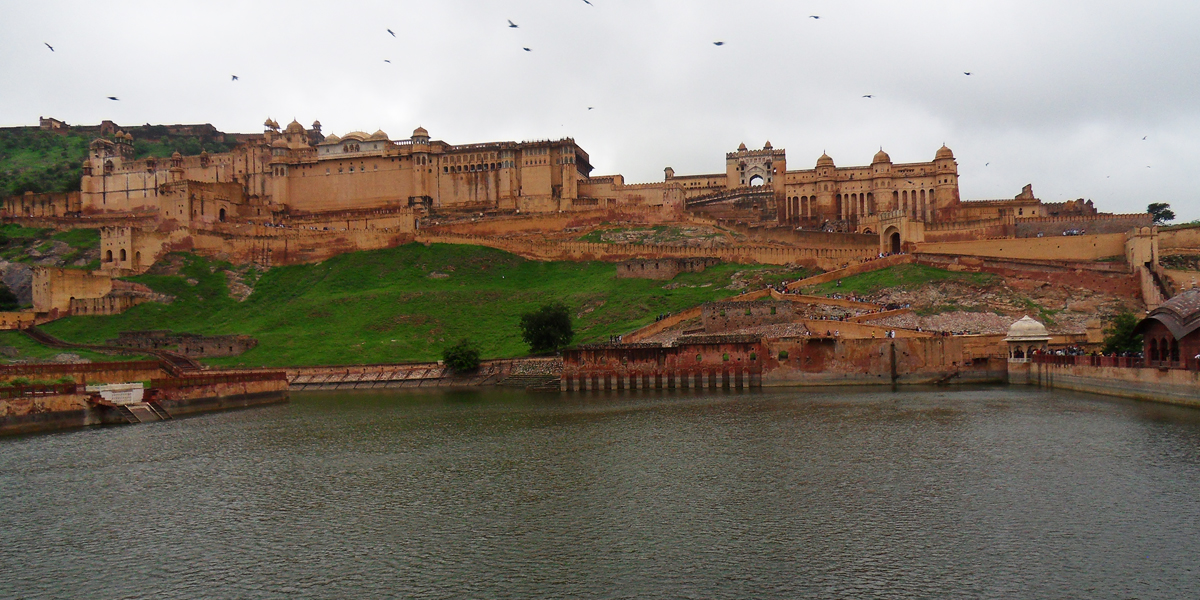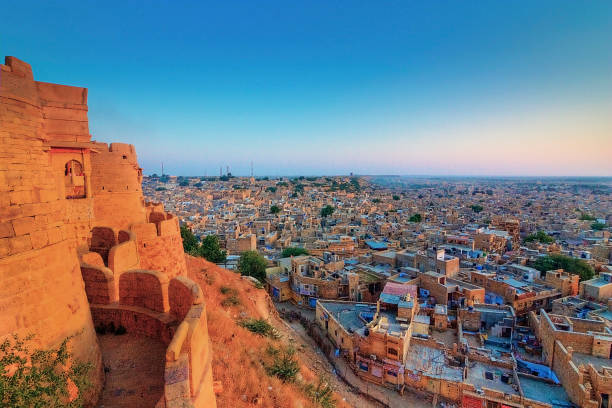Amer Fort in Jaipur
Nostalgic Amber Fort, near Jaipur in Rajasthan, is one of the most well-known and most-visited forts in India. Amber Fort is about 20 minutes northeast of Jaipur's city center.

Located on the foot of the Aravalli range and overlooking the Maota Lake, the Amber (Amer) Fort is famed for its artistic craftsmanship that is laid on a four level layout. It is one of the best places to visit in Jaipur.
Amer Fort is in Amer town of Jaipur district. Amer fort is 11 kms away from walled city of Jaipur in the valley of Aravali hills.
Fast Facts
Location: Jaipur, Rajasthan
Built By: Raja Man Singh
Built in the Year: 1592
Materials Used: Red sandstone and marble
Purpose: Main residence of the Rajput Maharajas
Current Status: Amber fort was declared as UNESCO World Heritage Site
Visit Timing: 8am - 5: 30pm
Amber was once the capital of princely Jaipur state, and the fort the residence of its Rajput rulers. Maharaja Man Singh I, who led Mughal Emperor Akbar's army, commenced its construction in 1592 on the remains of an 11th-century fort. Successive rulers added to Amber Fort before moving the capital to Jaipur in 1727. The fort was declared a UNESCO World Heritage site in 2013, as part of a group of six hill forts in Rajasthan. Its architecture is a noteworthy fusion of Rajput (Hindu) and Mughal (Islamic) styles.
Known for its artistic style, Amber fort or Amer fort is divided into four different parts. The architectural layout of the fort is such each part of it comes with a separate entrance. The prime entry of the fort is to be done through Suraj Pole (Sun Gate), which opens at the first main courtyard, known as the Jaleb chowk. This huge courtyard has a history of being the victory parade spot of the armies on returning from battles. The women folk of the Royal family used to witness the parades through latticed windows of the structure.
Reason behind naming it as Sun gate lies in its location, which faces the rising sun in the east. Jaleb Chowk was built during the reign of Sawai Jai Singh. The first courtyard of the Amber fort comprises various internal structures that held great purpose and significance for the royal family.
Amer is epitome of Rajput royalty and culture. Amer fort is perfect example of Rajput Military Hill architecture. Strategically built over ‘Cheel ka Teela’ (meaning home of high flying hawks), it signifies the elevation of the fort. On one side of the fort is Maotha Lake and other side is protected by thick forest.
The architectural marvel of Amer Fort is made of red sandstone, marble and big stone blocks. The bright yellow colour of fort shines when sun rays fall on it. The large fort contrasts with Maotha Lake and surrounding thick forests.
Suraj Pole Gate – The main entry gate to the fort is called Suraj Pole gate as it faces east. The huge entry gate signifies the prosperity and ensures proper passage for elephants. The suraj pol gate was used by armies to march in after victories in war.
Jaleb Chowk – Jaleb Chowk in Arabic means Army’s assembly point. Jaleb Chowk in Amer Fort was used for armies, horses and elephants. Kings and generals used to inspect the march and received salutes by armies in this place. This is one of the four courtyards in Amer Fort.
Ganesh Pol – The courtyard of Jaleb Chowk leads to Ganesh Pol. Ganesh Pol is another fascinating gate of Amer Fort. It is painted with murals of Hindu gods. The gate is named after and dedicated to Lord Ganesh who is the god of prosperity in Indian culture. The gate is built in Mughal Rajput style and it is the main entry gate to private palace in Amer Fort. Suhag Mandir above the Ganesh Pol was used by ladies of Royal family to see ceremonies held in Diwan-i-Am through latticed windows.
Sheesh Mahal – Sheesh Mahal lkiterally means Palace of mirrors. Inside the Ganesh Pol of Amer Fort, on one side is Sheesh mahal. The building is covered with thousands of convex shaped mirrors. The wall and even the ceilings are covered with mirrors which produces glittering reflections in night. Sheesh Mahal was built by Man Singh in 16th Century.
Diwan-i-Am/Diwan-i-Khas – Diwan-i-Am is public audience hall. This courtyard is built with two even columns with 27 colonnades. Diwan-i-Am was used by king to hear grievances and petitions of general public. Diwan-i-Khas was used for discussions with elites.
Sila Devi Temple – Maharaja Man Singh l of Amber lost a battle against king Kedar of Pratapaditya in East Bengal. He prayed for victory to goddess Kali. Goddess Kali blessed him in dream and the result was overturned. Maharaja Man Singh l established his shrine in Amber in devotion. The idol of Sila or Shila which means stone slab was recovered from sea and later brought to Amber. Thus, the goddess is named Shila Mata.
Government has attempted to revive glorious past, culture and traditions of Amer in Light and Sound show. This attempt puts Amer fort on the list of night tourism in Jaipur.
Rajasthan being a desert is warm throughout the year at least during the day. Sometimes the sun can be unbearable. That is why, it is best to visit Jaipur during winter, from November to March.
